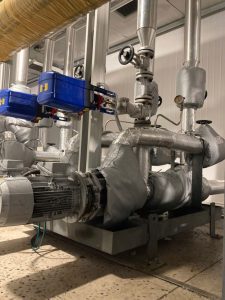An insulation jacket (also known as an insulation blanket or cover) is a smart, removable insulation solution, custom-tailored to snugly fit equipment, pipes, valves, and fittings in industrial environments. Not only does it help maintain stable temperatures to save energy, but it also plays a key role in ensuring worker safety and protecting machinery from harmful elements.
What is a removable insulation jacket?
A removable insulation jacket, also known as an insulation blanket or removable cover, is a system of insulation materials designed and fabricated to the specific shape of each piece of equipment.
The biggest difference from permanent insulation methods (like foam-in-place or metal cladding) is that an insulation jacket can be easily removed and reinstalled multiple times. This feature is extremely useful for maintenance, repairs, or periodic inspections without damaging the insulation structure. The primary goals of the product are to minimize heat loss, stabilize operating temperatures, prevent burn injuries, and extend the lifespan of machinery.
Standard 3-Layer Structure of an Insulation Jacket
A high-quality insulation jacket is typically composed of three main material layers, each serving a specific role to optimize overall performance.
Layer 1: Outer Fabric (Cover)
- Material: Typically Silicone-coated fabric, Teflon-coated fabric, or PU-coated fiberglass fabric.
- Function: This is the outer shield, responsible for resisting water, chemicals, abrasion, UV rays, and physical impacts from the environment. This layer also ensures the product’s aesthetic appeal.
Layer 2: Insulation Material (Core)
- Material: This is the heart of the insulation jacket, determining its thermal performance. The most common materials include Ceramic Fiber, Glass Wool, Aerogel, or E-glass felt.
- Function: Effectively prevents heat transfer between the equipment and the surrounding environment. The thickness and type of insulation material are selected based on the machinery’s actual operating temperature.
Layer 3: Inner Fabric (Hot Face)
- Material: Usually fiberglass fabric, Silica fabric, or other specialized high-temperature resistant fabrics.
- Function: This layer is in direct contact with the hot surface of the equipment. Its purpose is to withstand high temperatures and protect the inner insulation core from thermal degradation.
Additionally, insulation jackets are equipped with accessories such as high-temperature resistant straps, stainless steel hooks, and specialized Velcro fasteners to ensure the jacket is securely fastened and fits snugly around the equipment.
4 Key Benefits of Insulation Jackets in Industry
Investing in an insulation jacket system provides numerous practical and long-term benefits for businesses.
1. Save Energy, Optimize Costs
Insulation jackets significantly reduce heat loss to the environment. As a result, systems like boilers, steam pipes, and plastic injection molding machines can maintain stable temperatures without consuming extra energy to compensate for losses, directly reducing electricity bills and operating costs.
2. Ensure Absolute Worker Safety
By lowering the surface temperature of equipment to a safe level, insulation jackets effectively prevent the risk of burns to workers from accidental contact. The product also helps reduce noise emitted from machinery, creating a safer and more comfortable work environment.
3. Protect and Extend Equipment Lifespan
The outer shell of the insulation jacket helps protect machinery from chemical corrosion, weather effects (sun, rain), and mechanical impacts. Maintaining an ideal operating temperature also helps the equipment run more reliably and for a longer time.
4. Flexible and Convenient for Maintenance
This is their greatest advantage. Insulation jackets are designed for quick and easy removal and installation. When equipment needs inspection, maintenance, or repair, the technical team can remove the jacket and reinstall it intact without the significant time or cost associated with demolishing permanent insulation.
Common Applications of Insulation Jackets
With their high flexibility and effectiveness, insulation jackets are widely used in many industries:
- Piping Systems: Insulating hot steam pipes, oil lines, chemical lines, and fittings such as valves, elbows, tees, flanges, and expansion joints.
- Plastics and Rubber Industry: Insulating barrels and die heads of plastic injection molding machines, extruders, and blow molding machines.
- Thermal Systems: Insulating boiler bodies, furnaces, flue gas ducts, and auxiliary equipment.
- Engines and Machinery: Insulating marine engines, generators, and exhaust systems to reduce engine room temperature and noise.
- Food & Pharmaceutical Industry: Maintaining precise temperatures for tanks and pipes in production and processing lines.
Contact Us for Custom Insulation Jacket Consultation and Fabrication
To select the most suitable insulation jacket, businesses need to clearly define factors such as operating temperature, working environment, and the specific shape of the equipment. Contact reputable suppliers for a consultation on the right solution and a detailed quote to ensure the product is optimally designed for your needs.
Request consultation and quotation now!Frequently Asked Questions
What is a removable insulation jacket?
An insulation jacket is a custom-designed thermal cover for equipment that can be easily removed and reinstalled. It helps reduce heat loss, save energy, and ensure worker safety.
What are insulation jackets made of?
A standard insulation jacket consists of 3 layers: a weather-resistant outer fabric, an insulation core (ceramic fiber, glass wool, etc.), and a high-temperature resistant inner fabric.
Why use removable insulation jackets instead of permanent insulation?
Because insulation jackets are highly flexible, allowing for quick removal and reinstallation for equipment maintenance and repair without damaging the insulation structure, which saves time and money in the long run.
What temperatures can insulation jackets withstand?
Depending on the materials used, an insulation jacket can be designed to withstand a wide range of temperatures, from moderate to very high, often up to 1000°C (1832°F) or more.
How much does an insulation jacket cost?
The cost depends on several factors, such as the size and complexity of the equipment, the materials used, and the temperature requirements. You should contact a supplier directly for an accurate quote.
Are insulation jackets difficult to install?
No. Insulation jackets are designed for easy installation and removal using the included straps, buckles, and fastening systems, and do not require complex technical skills.










